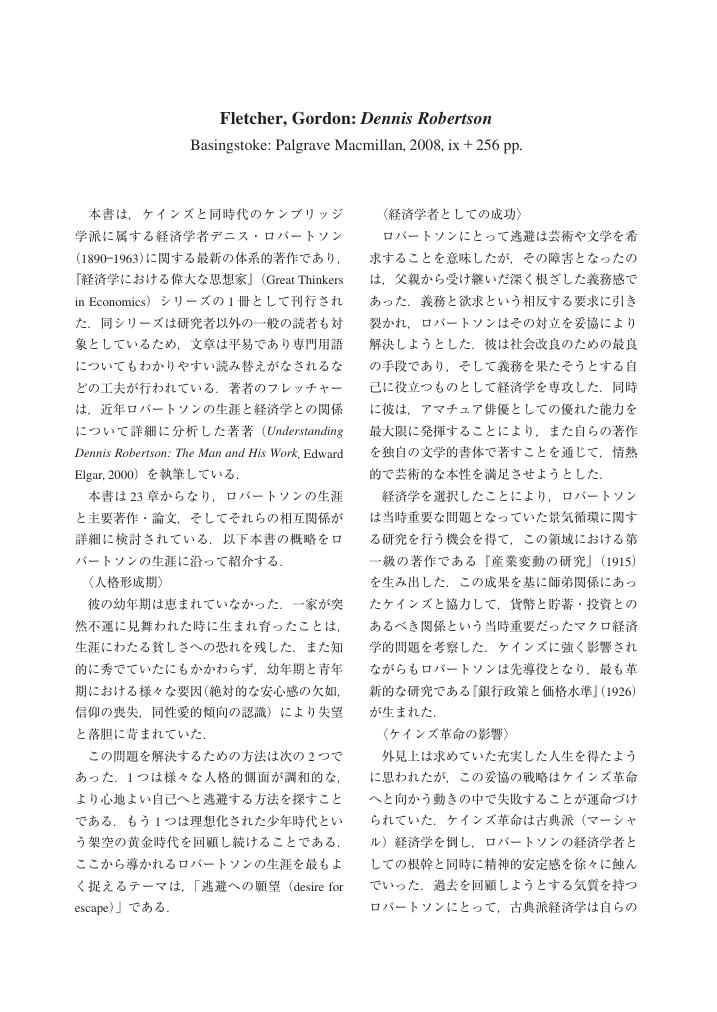1 0 0 0 OA ウィリアム・カップの科学統合論と累積的因果関係論
- 著者
- 山根 卓二
- 出版者
- 経済学史学会
- 雑誌
- 経済学史研究 (ISSN:18803164)
- 巻号頁・発行日
- vol.52, no.1, pp.50-66, 2010 (Released:2019-08-20)
This paper aims to study the characteristics of the principles of Karl William Kapp’s cumulative causation. While Kapp’s cumulative causation is strongly influenced by that of Gunnar Myrdal, it is not a model that merely explains disequilibrium or the “vicious circle” phenomena. Kapp was always interested in constructing a model that addresses issues arising from the compartmentalization of modern sciences. Therefore, his critique of mainstream economics should be understood in this context. Kapp argued that the approaches of mainstream economics were misleading because they isolated economic systems from non-economic elements. According to him, the trend toward the compartmentalization of mainstream economics could be inhibited by employing a cumulativecausation approach. Kapp’s institutional economics, which integrates cumulative causation, is an approach that refutes the atomistic views of the world proposed by mainstream economics. Through these atomistic views, individuals regarded as eternal; however, Kapp’s approach regards them as transient phenomena appearing in holistic dynamic processes. Furthermore, his approach shows that a human being is an existence with a multi-level construction. A human being is a “bio-cultural” existence that grows physically and personally, incorporating material and energy from nature, and culture from the society. Some societies ignore the latent ability of their members and attempt to limit them to the mould of a particular culture. Kapp described this aspect by means of principles of cumulative causation. JEL classification numbers: B 25, B 31, Q 50.
- 著者
- 下平 裕之
- 出版者
- 経済学史学会
- 雑誌
- 経済学史研究 (ISSN:18803164)
- 巻号頁・発行日
- vol.51, no.2, pp.106-107, 2009 (Released:2019-08-08)
1 0 0 0 OA 岩下伸朗『マーシャル経済学研究』 ナカニシヤ出版,2008,xiv+315 頁
- 著者
- 礒川 曠
- 出版者
- 経済学史学会
- 雑誌
- 経済学史研究 (ISSN:18803164)
- 巻号頁・発行日
- vol.51, no.2, pp.108-109, 2009 (Released:2019-08-08)
- 著者
- 松永 友有
- 出版者
- 経済学史学会
- 雑誌
- 経済学史研究 (ISSN:18803164)
- 巻号頁・発行日
- vol.51, no.2, pp.110-111, 2009 (Released:2019-08-08)
- 著者
- 竹永 進
- 出版者
- 経済学史学会
- 雑誌
- 経済学史研究 (ISSN:18803164)
- 巻号頁・発行日
- vol.51, no.2, pp.112-113, 2009 (Released:2019-08-08)
1 0 0 0 OA 佐藤方宣 編『ビジネス倫理の論じ方』 ナカニシヤ出版,2009,vii+282 頁
- 著者
- 井上 義朗
- 出版者
- 経済学史学会
- 雑誌
- 経済学史研究 (ISSN:18803164)
- 巻号頁・発行日
- vol.51, no.2, pp.114-115, 2009 (Released:2019-08-08)
- 著者
- 山崎 聡
- 出版者
- 経済学史学会
- 雑誌
- 経済学史研究 (ISSN:18803164)
- 巻号頁・発行日
- vol.51, no.2, pp.116-117, 2009 (Released:2019-08-08)
- 著者
- 柳沢 哲哉
- 出版者
- 経済学史学会
- 雑誌
- 経済学史研究 (ISSN:18803164)
- 巻号頁・発行日
- vol.51, no.2, pp.118-119, 2009 (Released:2019-08-08)
1 0 0 0 OA 根岸 隆『経済学の理論と発展』 ミネルヴァ書房,2008,vi+296 頁
- 著者
- 千賀 重義
- 出版者
- 経済学史学会
- 雑誌
- 経済学史研究 (ISSN:18803164)
- 巻号頁・発行日
- vol.51, no.2, pp.120-121, 2009 (Released:2019-08-08)
1 0 0 0 OA カール・ポランニーの「経済社会学」の誕生 『大転換』から『人間の経済』へ
- 著者
- 若森 みどり
- 出版者
- 経済学史学会
- 雑誌
- 経済学史研究 (ISSN:18803164)
- 巻号頁・発行日
- vol.51, no.2, pp.33-50, 2009 (Released:2019-08-08)
- 参考文献数
- 50
1 0 0 0 OA A. マーシャルにおける心理学研究と経済学との連関
- 著者
- 松山 直樹
- 出版者
- 経済学史学会
- 雑誌
- 経済学史研究 (ISSN:18803164)
- 巻号頁・発行日
- vol.51, no.2, pp.51-67, 2009 (Released:2019-08-08)
- 参考文献数
- 59
1 0 0 0 OA 『経済思想』(全11 巻,日本経済評論社,2004―07 年)に学ぶ
- 著者
- 中村 廣治
- 出版者
- 経済学史学会
- 雑誌
- 経済学史研究 (ISSN:18803164)
- 巻号頁・発行日
- vol.51, no.2, pp.94-101, 2009 (Released:2019-08-08)
- 著者
- 太田 仁樹
- 出版者
- 経済学史学会
- 雑誌
- 経済学史研究 (ISSN:18803164)
- 巻号頁・発行日
- vol.51, no.2, pp.102-103, 2009 (Released:2019-08-08)
- 著者
- 髙 哲男
- 出版者
- 経済学史学会
- 雑誌
- 経済学史研究 (ISSN:18803164)
- 巻号頁・発行日
- vol.51, no.2, pp.104-105, 2009 (Released:2019-08-08)
- 被引用文献数
- 1
- 著者
- 小林 純
- 出版者
- 経済学史学会
- 雑誌
- 経済学史研究 (ISSN:18803164)
- 巻号頁・発行日
- vol.51, no.1, pp.107-108, 2009 (Released:2019-06-22)
- 著者
- 田中 秀夫
- 出版者
- 経済学史学会
- 雑誌
- 経済学史研究 (ISSN:18803164)
- 巻号頁・発行日
- vol.51, no.1, pp.109-110, 2009 (Released:2019-06-22)
- 著者
- 服部 正治
- 出版者
- 経済学史学会
- 雑誌
- 経済学史研究 (ISSN:18803164)
- 巻号頁・発行日
- vol.51, no.1, pp.111-112, 2009 (Released:2019-06-22)
- 著者
- 塚本 隆夫
- 出版者
- 経済学史学会
- 雑誌
- 経済学史研究 (ISSN:18803164)
- 巻号頁・発行日
- vol.51, no.1, pp.113-114, 2009 (Released:2019-06-22)
1 0 0 0 OA 中村隆之『ハロッドの思想と動態経済学』 日本評論社,2008,xiii+238 頁
- 著者
- 井上 義朗
- 出版者
- 経済学史学会
- 雑誌
- 経済学史研究 (ISSN:18803164)
- 巻号頁・発行日
- vol.51, no.1, pp.115-116, 2009 (Released:2019-06-22)
- 著者
- 池田 毅
- 出版者
- 経済学史学会
- 雑誌
- 経済学史研究 (ISSN:18803164)
- 巻号頁・発行日
- vol.51, no.1, pp.117-118, 2009 (Released:2019-06-22)


















